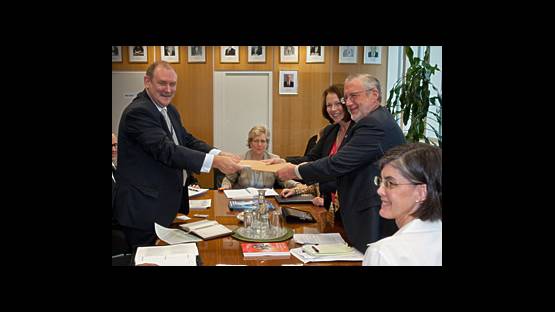A Nuclear Power Human Resources (NPHR) modelling tool, provided cost-free to the IAEA by the US Government, will be invaluable in helping Member States to understand their workforce requirements when planning to start a nuclear power programme.
The U.S. Department of Energy's Assistant Secretary for Nuclear Energy, Dr. Peter B. Lyons, handed over the modelling tool to Alexander Bychkov, IAEA Deputy Director General for Nuclear Energy, at their meeting during the IAEA General Conference on 20 September 2011.
"This tool can be an excellent way for Member States to plan for human resource development and is a good example of the potential for cooperation among the IAEA, the USA and the International Framework for Nuclear Energy Cooperation (IFNEC)," said Alexander Bychkov, Deputy Director General for Nuclear Energy while accepting the modelling tool.
The U.S. has offered the IAEA free use of the modelling tool with its Member States. For its part, the IAEA is working with the developers to create a user's manual and training materials. The Agency also proposed plans to pilot the model's use among IAEA Member States in 2012, a program funded by the Peaceful Uses Initiative.
The model's structure is consistent with the IAEA Guidance on the Milestones approach in the development of a national infrastructure for nuclear power and the NE Series Report on Workforce Planning published in 2011. The modelling tool was originally developed by Los Alamos National Laboratory under contracts with the Office of Nuclear Energy/Department of Energy and the National Nuclear Security Administration as part of the US participation in IFNEC.
Background
When countries consider adding nuclear power to the energy delivery infrastructure they need to know the number and types of qualified personnel that will be required to support the planning, procurement, construction, licensing, regulation, start-up and operation of a nuclear power plant. The skill sets required differ from country to country and depend upon the kind of reactor design used, as well as the existing national power and regulatory infrastructure. Planning is thus essential to ensure that the necessary educational programmes are in place to be able to deliver qualified personnel. Work force planning is an important component in the overall strategy for national infrastructural development.


